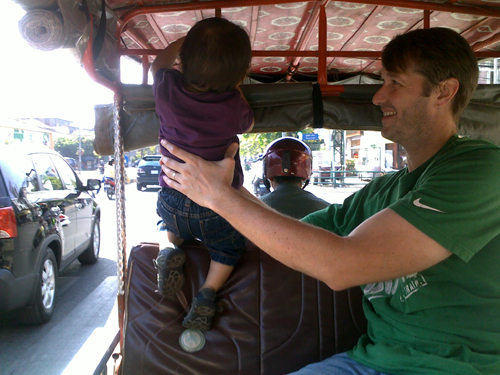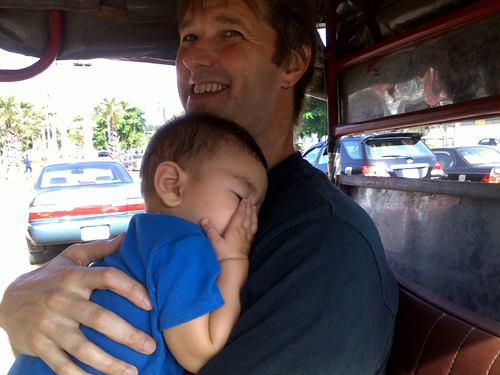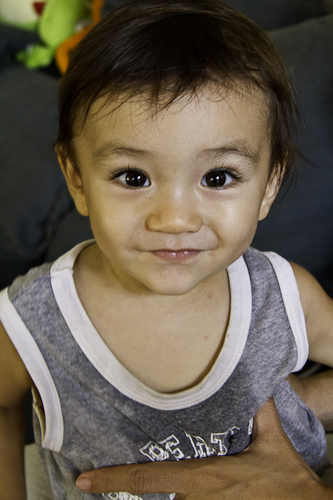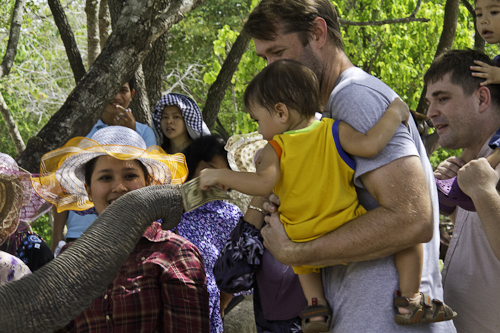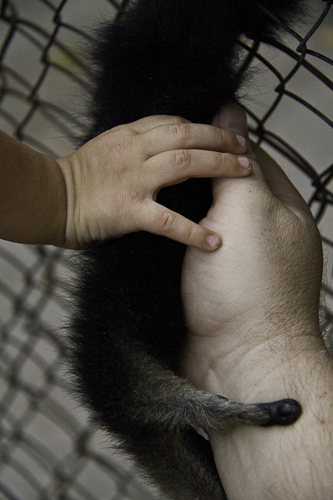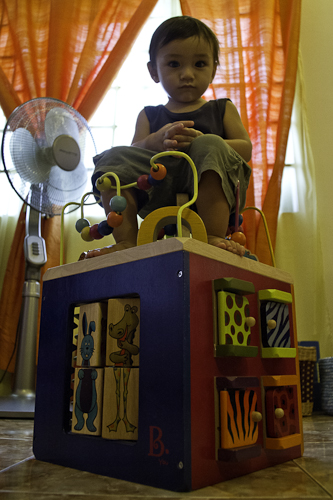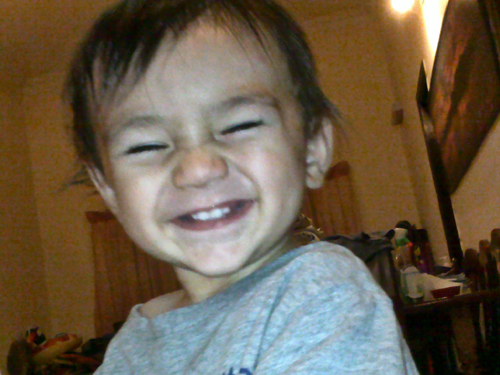This little monkey is a a terror in the tuk-tuk. Thankfully the tuk tuk driver, Rithy, drives fairly slowly and cautiously, occasionally watching the boy from the rearview mirrors to make sure he hadn’t fallen out (which is sadly his only use of these implements that we can determine). But luckily he fell asleep after we let him use the vehicle as a jungle gym for 20 minutes. A sleeping boy makes for a happy Papa!
Life
the problem with the way we handled attachment parenting
The above image is from the 21 May 2012 issue of TIME magazine. “Are you mom enough?” – That headline just grabs you, doesn’t it, questioning your values and your parenting.
One thing we didn’t anticipate, in all the planning and discussions about attachment parenting, is the difficulties in teaching our son to put himself to sleep, and to soothe himself back to sleep when he twitches awake in the night – without me.
For the past 16 months I was perfectly happy to oblige his every request. I’m quite fortunate to work for an employer who’s flexible to the needs of new mothers. There’s a nursery at the office so you can nurse or pump during the workday, and until the child is a year old s/he and the nanny can be taken on work trips to the provinces.
Plus, the boy is not a cuddler, so the time together -even when he wants to use me as a pacifier for extended periods of time- is precious to me.
Hubby and I just assumed he would eventually begin nursing less at night. But he hasn’t, and now it’s starting to feel like a chain. We’ve tried all the “gentle” ways to teach our son to sleep (we bought all the Pantley books). And after trying for six months, none of the recommendations worked. We’d like to once in a while have a quiet night in, watching a movie after he falls asleep. Instead, every night starting around seven (I get home from work around 530-6pm), we begin his bedtime routine and he falls asleep anywhere between 2-3 hours later!, nursing!
So today is Day One of detachment parenting, where I’ll sleep at our neighbor’s every night until our son can (hopefully!) put himself to sleep with just Papa in the house. There’ll be a lot of crying and temper tantrums from this high-need little baby, but hopefully there’s sanity at the end of the tunnel. This isn’t to say we don’t recommend attachment parenting, just that we’d probably attack the sleep issue early on and not let it become a problem.
Healthy baby girl, FREE to whoever can feed her
As a mom, it tears at my heart. It was shocking at the same time that I know it meant a better life for the baby.
It’s commonplace, but I don’t often personally see or hear of it. A woman gave birth to a healthy baby girl around 7am, at a health center where we were field-testing some questionnaires. Usually anyone admitted to a facility is accompanied by throngs of family members, who provide the care to the patient that back home would be done by health staff (eg providing meals, making sure medicines are taken, changing the dressings etc). But there was no one with this very young mother. She was thin, ragged, and very weak. She breastfed the baby a bit, on prompting by the staff, but by evening someone noticed that she hadn’t eaten all day. She couldn’t afford it – not even a bowl of porridge (around 2000 Riel or US$0.50) from the lady carrying pots and bowls in baskets balanced on a bamboo pole.
The new mother asked the staff to look for someone to take the baby because she couldn’t afford to feed her. As it turns out, my colleague has an older sister who is unable to bear children, so she agreed to take the baby for her sister. She offered some money to the staff and the staff gave a portion of it to the mother.
My colleague’s sister has had the baby now for a week. She loves the baby like her own, and she registered the birth so according to official records she is the biological mother. I wondered about the poor woman, but my colleague has no plans to find her or keep in touch. I suppose that’s only natural.
As a side note, civil registration was introduced in Cambodia only as recently as 2002, and by 2005 only 5% of the population was registered. There’s no requirement on health facilities to do more than report the number of births (to the Ministry of Health). The family takes responsibility for registering the birth (to the Sangkat or Commune, who facilitates the registration with the Ministry of Interior and birth certificate to the baby). This proof of existence is a person’s ticket to citizenship and provides the evidence needed for claims to social services and benefits. A country’s database of vital events like births, deaths, marriages helps the government determine the best use of resources eg public health programming.
Phnom Tamao Wildlife Sanctuary
Desperately seeking green spaces in Phnom Penh?
Just 40 km outside Phnom Penh is a rescue center for injured or trafficked animals. There are over 80 species including macaques, lions, tigers, bears, gibbons and crocodiles – most are endangered, rescued from the wildlife trade. The sanctuary sprawls across 2500 hectares of protected forest.
It wasn’t as terrible as I expected (small concrete cages with animals pacing in the heat, going mad) and the handlers are quite knowledgeable. Tristan got to see many animals he has only ever seen in pictures. To boot, there are a lot of trees with shaded areas. They’re working on putting the crocodiles on a feeding schedule so that they can put shows on during the weekends like the elephants do.
We’ll be going back for another visit! The images above are from Keith Kelly’s photostream of Phnom Tamao Wildlife Sanctuary. And Wildlife Alliance has great coverage of the animals and events at the zoo. Chhouk the elephant with a prosthetic leg was even featured on the TODAY show in the US back in November 2011.
Update Feb 10, 2014: We had a birthday party at Phnom Tamao this year, which was a great hit!
building communication skills to help with the Terrible Twos
At 15 months, we’re getting a premature taste of the infamous Terrible Two stage. Our little boy’s personality seems to be developing along what the books call “spirited” or “strong-willed”, even “high-need” (although this last term is politically incorrect anymore). His Khmer nanny is bewildered and amused at the range, intensity and volatility of emotion he exhibits. He can be blissfully happy one second and thrashing about in a full rage for the next two hours. It sets him off when we don’t understand what he wants. With redirecting a bit more difficult now we’ve had to be creative.
Thankfully he’s developed some decent communication skills early on. The fact that signing and verbalizing are still novel to him at this stage, and that it gets a lot of positive attention, means we can exploit this! So we’re trying to help him realize that there are better ways to get his point across than through a tantrum.
He can sign. We signed to him since he was just a few weeks old, so he knows the basic ones like mum-mum (mom’s milk), finished, change the diaper, hurt and sleep. He demonstrates that he understands the signs but he doesn’t use all of them.
His verbal skills are excellent. His first words at just a little over a year old were mum-mum, chkai (dog), fish and turtle. Today his ramblings are sprinkled with big words or phrases like elephant (“puh-pet”), octopus (“AHH-puhpuh”), chipmunk (“muh-munk”), kangaroo (“rah-rah-rooo”), other side (“uhh-thuh-thai”).
And as with any multilingual and/or expatriate families, he’s is exposed to several languages. His nanny doesn’t speak English and most people he meets prattle at him in Khmer. I try to talk to him in Tagalog and one of our neighbors who he frequently interacts with speaks to him in Bengali.
Interestingly, he uses whichever language is easier for the word he wants to use. For example, he’ll say svai rather than mango, awluk rather than watermelon. We aren’t necessarily teaching him all four languages – but we want to give him that kind of exposure. I and most of my friends grew up in a 3+ language family and there’s increasing evidence it augments cognitive development. That he can choose between them to find the easiest way to say what he wants to say is a bonus!
And at this stage he gestures a lot. He asks to be picked up and we just follow his pointing signals.
The main point is that communication has been a huge tool in helping us deal with the Terrible Twos. It’s fascinating to watch this little boy communicating his wishes (what goes on in their little heads?!). He can now usually get his point across early so we can either accommodate him or anticipate and redirect temper flares. It’s a tiring and frustrating but very rewarding phase, “growing” this littler person!
Happy New Year!
It’s that time of year again… all productivity is grounding to a lazy halt across the Kingdom. The Mekong is reversing current, the air is scalding, the rainstorms are waiting on the periphery, and we’re celebrating the third New Year of the Gregorian calendar …
សូស្តីឆ្នាំថ្មី! ពីភ្នំពេញ
Chunpo Chnam Thmei!
Happy New Year from Phnom Penh!
